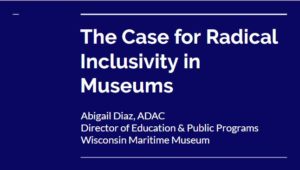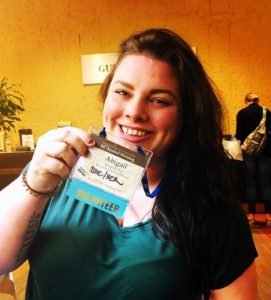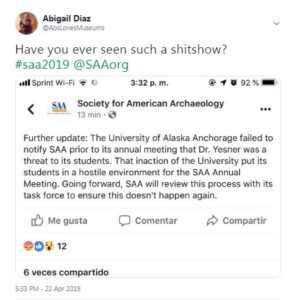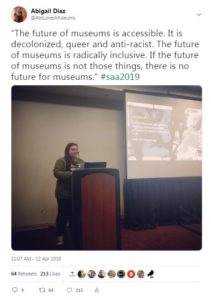Notes from the Field: A Museum Educator at an Archaeology Conference
This April, I was thrilled to present at the Society for American Archaeology’s (SAA) annual conference in Albuquerque,  New Mexico. Though I was an archaeologist in another life, it had been nearly a decade since I attended an archaeological conference and I had never presented at one. I’ve been to dozens of museum conferences and thought: “How different could it be?” Turns out, it could be, and was, a totally different beast.
New Mexico. Though I was an archaeologist in another life, it had been nearly a decade since I attended an archaeological conference and I had never presented at one. I’ve been to dozens of museum conferences and thought: “How different could it be?” Turns out, it could be, and was, a totally different beast.
While I’m still partial to the love fest at conferences like the Michigan Museum Association, American Alliance of Museums (AAM), and Association of Midwest Museums, there are some things to be learned by attending a large conference and seeing it through the perspective of an outsider.
Archaeology conferences are doing some things right:
 Each speaker within a session have an allotted time slot. So within my “Health, Wellness and Ability” session, I was in the program (and app!) as having my own time. People that were interested in a single presenter within a larger session could pop in and out with ease.
Each speaker within a session have an allotted time slot. So within my “Health, Wellness and Ability” session, I was in the program (and app!) as having my own time. People that were interested in a single presenter within a larger session could pop in and out with ease.- Speaking of the app, the SAA conference had a great app full of details and a schedule-builder. Conference programs can be so wasteful, so I love to see these digital options.
- I was thrilled to see pronoun stickers for name badges. These were provided by Queer Archaeology Interest Group and were a hit!
- Many archaeologists are academics and live by the ‘publish or perish’ mantra, and I loved hearing about so many sessions being published later. I wish I saw this happening more at museum conferences. (Speaking of which, consider writing for the Journal of Museum Education!)
Volunteer opportunities were plentiful and not just for students. This helped me be able to afford to come to the conference.
Museum conferences are crushin’:
- In my experience, museums tend to be more conscious of human remains in collections. There are warnings about the display of skeletal remains and collections professionals do not throw in these images unless it is essential to what is being discussed. This was not the case at the SAAs when many archaeologists posted human remains, victims of trauma, pathology and violence, because they were interesting background. This practice is an ongoing debate in the archaeological field.

- We’re doing a great job (and getting better at) critiquing our own field. Sessions at conferences oftentimes talk about privilege, power, and racism that is ingrained in our field. We’re also out here talkin’ about burn out, low pay and inequity.
- In general, I find museum conferences to be more cognitively accessible; so many of the archaeological presentations were filled with overly-academic vocab making it really hard to follow, even for someone in archaeology. The best educators and facilitators I know can make complex concepts consumable to all.
- Museums, and AAM in particular, are excelling in social media during conferences. AAM has paid social media journalists out and tweeting, they are responsive on their official account and they tweet sessions. SAA on the other hand, saw social media totally blow up when a #MeToo controversy broke out when a sexual predator attended the conference this year. No one was monitoring the Society for American Archaeology Twitter and then they officially blamed the university that fired the professor. It was…bad.
Both fields need to work on:
 I continue to be surprised to see so few land acknowledgements at conferences. How can we, as archaeologists, educators, museum professionals, ground our work in equity without reconciling with colonialism?
I continue to be surprised to see so few land acknowledgements at conferences. How can we, as archaeologists, educators, museum professionals, ground our work in equity without reconciling with colonialism?- What is the holdup on offering gender neutral bathrooms? (As a conference connoisseur, I can tell you that the American Library Association conference has the best bathrooms.)
- I’m having a harder and harder time being able to justify spending so much money on these huge conferences. While both SAA and AAM offered volunteer opportunities, the conference fees are bananas. SAA even requires you to be a member of the organization to present! With so many experiences that cost extra and so few actual sessions, regional and local conferences are becoming more of a draw.
- Both museums and archaeology continue to work to make both the fields and conferences a safe place. The “#MeToo in Archaeology” session overflowed into the hallways. It was so emotional and traumatic that counselors should have been made available. SAA is now (according to recent communications) requiring conference attendees to state whether they have been the subject of a sexual harassment investigation. I don’t know the best way to move forward but it’s a step forward in recognizing that amongst all the networking and mingling between sessions, harassment can happen too.
I’m proud to have been able to attend the Society for American Archaeology conference and present with some stellar women doing work in disability rights, wellness and health. While I miss excavating and my “office” being a hole in the ground, I’m thankful for what museums have taught me and for the conferences that continue to bring us together. Being an outsider at a conference like SAA and seeing it through this museum lens gave me a new perspective and renewed drive to propel forward inclusive initiatives across all fields. We all have work to do.
Abigail Diaz (she/hers) signs her emails “museums are for everyone” and works every day to make that a reality. Abbie has worked at 13 cultural institutions across four states. She is currently the Director of Education & Public Programs at the Wisconsin Maritime Museum and on the Board of Directors of the Museum Education Roundtable. You can find her at @AbsLovesMuseums on Twitter.

